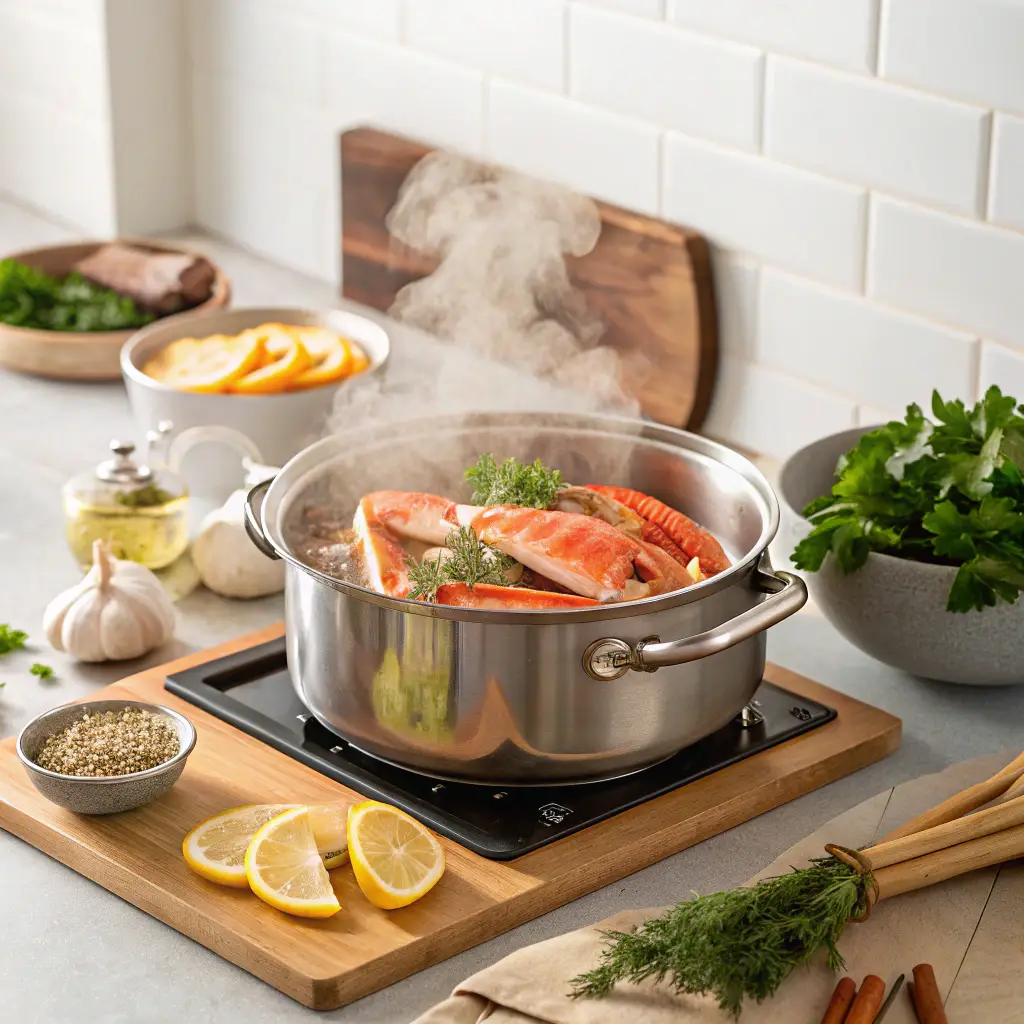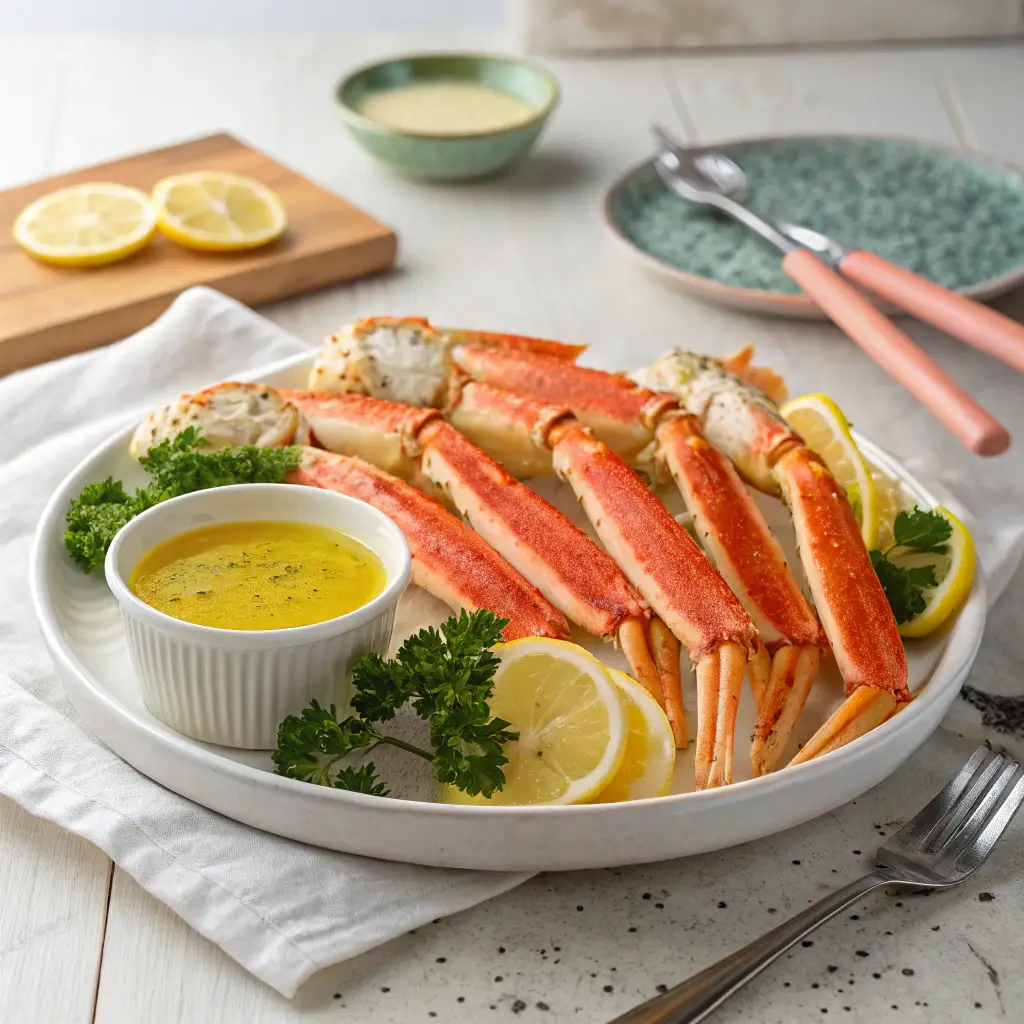Cooking frozen crab legs can seem like a daunting task, but it doesn’t have to be! Picture this: you’ve got a bag of delicious frozen crab legs, but you’re unsure how to transform them into a mouthwatering meal. Don’t worry—you’re not alone! Many people face the same challenge of wanting to enjoy seafood without the hassle. This article will guide you on how to cook frozen crab legs with ease, breaking it down into simple, foolproof steps. By the end, you’ll be whipping up perfectly cooked crab legs that rival any restaurant dish.
Imagine the delight of cracking open tender, juicy crab legs at home—no reservations required! Whether you’re planning a casual dinner or an impressive feast, this recipe is both versatile and healthy. Plus, with quick prep methods and tips for adding flavor, it’s a dish you’ll return to again and again. Ready to get started? Let’s dive in!
Table of Contents

Preparing Frozen Crab Legs for Cooking
Thawing Techniques for Frozen Crab Legs
Thawing frozen crab legs is the first step toward enjoying their fresh, oceanic flavor. If you’re in a hurry, don’t worry—there are several quick ways to get this done. The easiest method is placing them in the fridge overnight. This keeps the texture intact and avoids unnecessary wateriness. But if you’re short on time, try running them under cold water for about 20 minutes. Remember, patience pays off! Avoid using hot water, as it can start cooking the crab legs unevenly. Also, keep the crab legs in their packaging to maintain freshness during thawing. Preparing them right is like setting the stage for a performance—you want to get it just right. Once thawed, they’ll cook evenly and taste better. Thawing frozen crab legs doesn’t have to feel like a chore. Instead, think of it as the first exciting step toward a delicious meal!
Tools You Need to Get Started
Cooking frozen crab legs is easier when you’ve got the right tools. First, grab a large pot for boiling or steaming. Next, have a pair of tongs handy to lift the crab legs safely—trust me, they’ll make your life easier. A colander is useful for draining water, especially if you’re steaming. Also, consider a cracking tool for getting to the meat without the mess. Some people use kitchen shears for precision cutting, and they work wonders. Don’t forget the serving essentials! Have a few small bowls for melted butter or your favorite dipping sauces. If you love seasoning, a brush for basting can add extra flavor. Getting these tools ready is like gathering your team for a big game—each one plays an important role. With everything in place, you’re all set to cook those crab legs to perfection!
The Best Methods to Cook Frozen Crab Legs
Boiling Crab Legs for Perfect Texture
Boiling frozen crab legs is one of the easiest and most popular methods. First, fill a large pot with water and add a pinch of salt. Bring the water to a rolling boil, then carefully place the crab legs into the pot. Cover the pot and let them simmer for 4-5 minutes. You’ll notice their shells turning a vibrant red—that’s your cue that they’re ready! Be gentle when removing them with tongs to avoid breaking the legs. Boiling helps retain the natural moisture of the crab, making every bite juicy and tender. This method is perfect for anyone new to seafood cooking because it’s nearly foolproof. Once boiled, serve them hot with your favorite dipping sauce. Boiling frozen crab legs is quick, simple, and guarantees a restaurant-quality result in no time.
Steaming for Tender and Juicy Results
Steaming is a gentle method that preserves the natural sweetness of crab meat. First, place a steaming rack in a large pot and add about an inch of water. Next, bring the water to a boil and place the crab legs on the rack. Cover the pot tightly to trap the steam, and let them cook for 6-7 minutes. The steam heats the crab legs evenly, making them tender and flavorful. You’ll love how easy it is to prepare crab legs this way. Steaming also minimizes mess compared to boiling, which is always a bonus. Once they’re done, remove them carefully using tongs. Steamed crab legs pair beautifully with garlic butter or lemon wedges for a fresh, zesty touch. If you’re looking for a hassle-free method, steaming frozen crab legs is the way to go!
Tips for Enhancing Flavor When Cooking Frozen Crab Legs
Adding Seasonings and Aromatics
Want to take your crab legs to the next level? Adding seasonings and aromatics is the secret! Before cooking, sprinkle your crab legs with a mix of garlic powder, paprika, and a touch of cayenne for a little kick. If you’re boiling, toss a lemon slice, bay leaf, and a few garlic cloves into the water. They’ll infuse the crab legs with irresistible aromas. For steaming, brush the legs lightly with melted butter and your favorite spices before placing them in the pot. This small step makes a big difference. Seasoning crab legs is like giving them a personality—each bite will have a unique flavor! Whether you like bold spices or subtle hints of herbs, experimenting with flavors is part of the fun. Cooking frozen crab legs doesn’t just satisfy hunger; it’s also a chance to unleash your creativity in the kitchen.
Using Dipping Sauces to Elevate Taste
A good dipping sauce can transform crab legs into a culinary masterpiece. Classic melted butter is always a winner—just add a splash of lemon juice for a zesty twist. If you love bold flavors, try mixing mayonnaise with a touch of sriracha for a creamy, spicy dip. Another favorite is garlic aioli, which pairs wonderfully with the sweetness of crab meat. Dipping sauces aren’t just condiments—they’re the finishing touch to your dish. You can also prepare a light herb vinaigrette if you’re in the mood for something fresh and tangy. The key is to keep it simple yet flavorful. A great sauce enhances the natural taste of the crab without overpowering it. Whether you prefer spicy, tangy, or buttery, experimenting with sauces is part of the joy of cooking frozen crab legs.
Common Mistakes to Avoid While Cooking Frozen Crab Legs
Overcooking and How to Prevent It
Overcooking crab legs is a common mistake that can ruin their texture. It’s easy to get distracted and leave them in the pot too long. Remember, frozen crab legs are pre-cooked, so they only need reheating. Cooking them for too long makes the meat tough and stringy. Always keep an eye on the timer, and stick to the recommended cooking times. Boiling should take 4-5 minutes, while steaming requires 6-7 minutes. If in doubt, test a small piece for doneness. The key is to heat them just enough to bring out their natural flavors. Think of it like warming up leftovers—you don’t want them to dry out. Cooking frozen crab legs to perfection is all about timing. By avoiding overcooking, you’ll enjoy juicy, tender crab legs every time.
The Importance of Proper Timing
Timing is everything when cooking frozen crab legs. It’s tempting to rush the process, especially when you’re hungry, but patience is crucial. Starting with the right thawing method ensures even cooking, so don’t skip that step. When boiling or steaming, set a timer to avoid guesswork. Proper timing also includes prepping your tools and ingredients before cooking. This saves you from last-minute scrambling. If you’re planning to season the crab legs, do it while they’re still warm for better flavor absorption. Timing isn’t just about avoiding mistakes—it’s about creating a smooth, enjoyable cooking experience. Cooking frozen crab legs doesn’t have to be stressful when you plan ahead. With a little patience and preparation, you’ll have a seafood feast ready in no time.
Serving Suggestions for how to cook frozen crab legs
Pairing Crab Legs with Sides and Beverages
Cooked crab legs are a star dish, but the right sides and drinks make them shine even brighter. A simple side of steamed vegetables or a fresh salad complements the rich flavor of crab legs perfectly. For a more filling option, consider pairing them with buttery mashed potatoes or a light pasta dish. When it comes to beverages, a refreshing glass of lemonade or iced tea works wonders. If you’re hosting a dinner, serve crab legs with a platter of fresh bread or rice pilaf. Pairing your meal thoughtfully elevates the dining experience. Crab legs are versatile, so feel free to experiment with side dishes and drinks to suit your taste. Cooking frozen crab legs is just the start—how you serve them makes all the difference!
Presentation Tips for an Impressive Meal
Presentation matters, especially when serving crab legs to guests. First, arrange the legs neatly on a large platter for a clean, inviting look. Adding garnishes like fresh parsley or lemon wedges brings color and vibrancy to the dish. If you’ve prepared dipping sauces, place them in small bowls around the platter for easy access. Using decorative plates or napkins adds a festive touch, especially for special occasions. Presentation isn’t just about looks—it’s about making the meal feel extra special. Cooking frozen crab legs becomes even more rewarding when you see the smiles on everyone’s faces. Whether it’s a family dinner or a fancy gathering, taking a few minutes to plate the dish beautifully shows care and creativity. Simple touches can turn a meal into a memorable experience.
A Delicious Complement: Salmon-Topped Sushi Dishes
If you love seafood, why stop at crab legs? Expand your culinary experience by trying out salmon-topped sushi dishes. These dishes are not only flavorful but also a perfect complement to your crab leg feast. The rich, buttery texture of salmon pairs beautifully with the tender sweetness of crab meat. For more seafood inspiration, check out this delicious recipe: Salmon-Topped Sushi Dishes. If you’re looking to expand your seafood recipe collection, Allrecipes offers a comprehensive selection of dishes featuring fish, shellfish, and hearty chowders. Their user-friendly platform provides detailed instructions and reviews to help you create delicious seafood meals at home.
FAQs
What is the best way to cook frozen crab legs?
The best way to cook frozen crab legs depends on your preference and available time. For quick results, boiling is ideal. It’s easy, fast, and keeps the meat juicy. If you prefer a more tender texture and want to preserve the natural sweetness, steaming is a great option. Both methods are simple and reliable, ensuring perfectly cooked crab legs every time. Also, you can try baking them for a rich, roasted flavor. Choose the method that suits your taste and schedule, and you can’t go wrong.
Do you need to thaw frozen crab legs before cooking?
Thawing frozen crab legs before cooking is recommended, but it’s not always necessary. If you have time, thaw them in the fridge overnight for even cooking. This step ensures they heat evenly and taste their best. However, you can cook them straight from frozen by simply adding a few extra minutes to the cooking time. Either way works, but thawing makes the process smoother and the results more consistent.
Is it better to steam or bake frozen crab legs?
Steaming is better if you want to preserve the crab’s natural flavor and moisture. It’s quick, easy, and keeps the meat tender. Baking, on the other hand, offers a different experience. It allows you to season the crab legs more creatively and adds a slightly roasted taste. Both methods are excellent, so choose steaming for simplicity or baking for a flavor-packed twist.
Is it better to boil or steam crab legs?
Boiling is better if you’re looking for a quick and foolproof method. It’s perfect for cooking large quantities and ensures juicy crab meat. Steaming, however, is ideal if you want to preserve the delicate flavor and avoid waterlogging the meat. Both methods work well, but steaming offers a slightly sweeter and firmer texture. Consider the time and tools you have to pick the method that suits your needs!
Conclusion :
Cooking frozen crab legs doesn’t have to be complicated or intimidating. With the right steps, tools, and tips, you can create a meal that’s both delicious and satisfying. First, take the time to properly thaw your crab legs for even cooking. Next, choose a cooking method that suits your style, whether it’s boiling or steaming. Don’t forget to add seasonings and pair your meal with flavorful dipping sauces. These small touches make a big difference. Also, watch your timing to avoid common mistakes like overcooking. Then, focus on presentation to impress your family or guests. Finally, serve your crab legs with complementary sides and beverages for a complete dining experience. You’re going to love how easy and fun it is to prepare this seafood treat. Follow these steps, and you’ll master how to cook frozen crab legs like a pro. Now, it’s time to enjoy your perfect crab feast!

